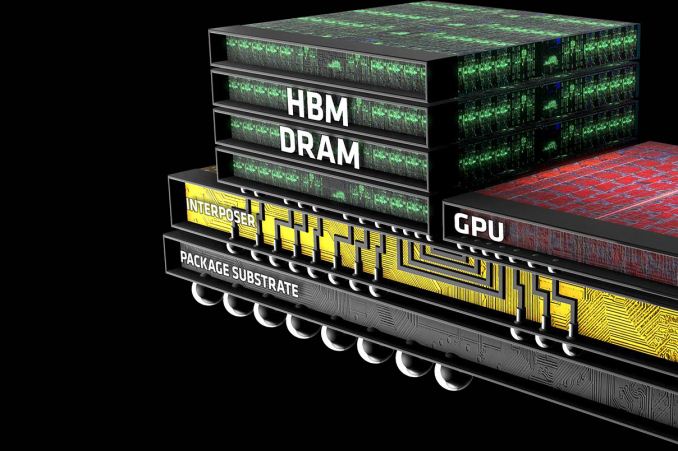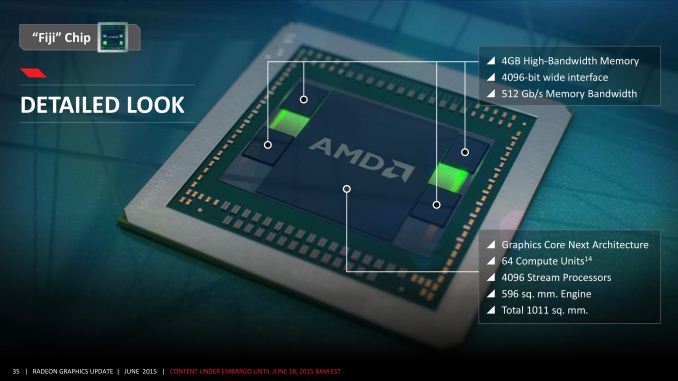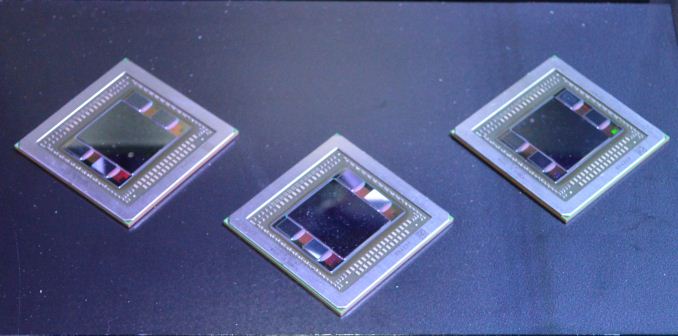The AMD Radeon R9 Fury X Review: Aiming For the Top
by Ryan Smith on July 2, 2015 11:15 AM ESTThe Fiji GPU: Go Big or Go Home
Now that we’ve had a chance to take a look at the architecture backing Fiji, let’s talk about the Fiji GPU itself.
Fiji’s inclusion of High Bandwidth Memory (HBM) technology complicates the picture somewhat when talking about GPUs. Whereas past GPUs were defined by the GPU die itself and then the organic substrate package it sits on, the inclusion of HBM requires a third layer, the silicon interposer. The job of the interposer is to sit between the package and the GPU, serving as the layer that connects the on-package HBM memory stacks with the GPU. Essentially a very large chip without any expensive logic on it, the silicon interposer allows for finer, denser signal routing than organic packaging is capable of, making the ultra-wide 4096-bit HBM bus viable for the first time.
We’ll get to HBM in detail in a bit, but it’s important to call out the impact of HBM and the interposer early, since they have a distinct impact on how Fiji was designed and what its capabilities are.
As for Fiji itself, Fiji is unlike any GPU built before by AMD, and not only due to the use of HBM. More than anything else, it’s simply huge, 596mm2 to be precise. As we mentioned in our introduction, AMD has traditionally shied away from big chips, even after the “small die” era ended, and for good reason. Big chips are expensive to develop, expensive to produce, take longer to develop, and yield worse than small chips (this being especially the case early-on for 40nm). Altogether they’re riskier than smaller chips, and while there are times where they are necessary, AMD has never reached this point until now.
The end result is that for the first time since the unified shader era began, AMD has gone toe-to-toe with NVIDIA on die size. Fiji’s 596mm2 die size is just 5mm2 (<1%) smaller than NVIDIA’s GM200, and more notably still hits TSMC’s 28nm reticle limit. TSMC can’t build chips any bigger than this; Fiji is as big a chip as AMD can order.
| AMD Big GPUs | ||||
| Die Size | Native FP64 Rate | |||
| Fiji (GCN 1.2) | 596mm2 | 1/16 | ||
| Hawaii (GCN 1.1) | 438mm2 | 1/2 | ||
| Tahiti (GCN 1.0) | 352mm2 | 1/4 | ||
| Cayman (VLIW4) | 389mm2 | 1/4 | ||
| Cypress (VLIW5) | 334mm2 | 1/5 | ||
| RV790 (VLIW5) | 282mm2 | N/A | ||
Looking at Fiji relative to AMD’s other big GPUs, it becomes very clear very quickly just how significant this change is for AMD. When Hawaii was released in 2013 at 438mm2, it was already AMD’s biggest GPU ever for its time. And yet Fiji dwarfs it, coming in at 158mm2 (36%) larger. The fact that Fiji comes at the latter-half of the 28nm process’s life time means that such a large GPU is not nearly as risky now as it would have been in 2011/2012 (NVIDIA surely took some licks internally on GK110), but still, nothing else we can show you today can really sell the significance of Fiji to AMD as much as the die size can.
And the fun doesn’t stop there. Along with producing the biggest die they could, AMD has also more or less gone the direction of NVIDIA and Maxwell in the case of Fiji, building what is unambiguously the most gaming/FP32-centric GPU the company could build. With GCN supporting power-of-two FP64 rates between 1/2 and 1/16, AMD has gone for the bare minimum in FP64 performance that their architecture allows, leading to a 1/16 FP64 rate on Fiji. This is a significant departure from Hawaii, which implemented native support for ½ rate, and on consumer parts offered a handicapped 1/8 rate. Fiji will not be a FP64 powerhouse – its 4GB of VRAM is already perhaps too large of a handicap for the HPC market – so instead we get AMD’s best FP32 GPU going against NVIDIA’s best FP32 GPU.
AMD’s final ace up their sleeve on die size is HBM. Along with HBM’s bandwidth and power benefits, HBM is also much simpler to implement, requiring less GPU space for PHYs than GDDR5 does. This is in part due to the fact that HBM stacks have their own logic layer, distributing some of the logic on to each stack, and furthermore a benefit of the fact that the signaling logic that remains doesn’t have to be nearly as complex since the frequencies are so much lower. 4096-bits of HBM PHYs still takes up a fair bit of space – though AMD won’t tell us how much – but it’s notably lower than the amount of space AMD was losing to Hawaii’s GDDR5 memory controllers.
The end result is that not only has AMD built their biggest GPU ever, but they have done virtually everything they can to maximize the amount of die space they get to allocate to FP32 and rendering resources. Simply put, AMD has never reached so high and aimed for parity with NVIDIA in this manner.
Ultimately this puts Fiji’s transistor count at 8.9 billion transistors, even more than the 8 billion transistors found in NVIDIA’s GM200, and, as expected, significantly more than Hawaii’s 6.2 billion. Interestingly enough, on a relative basis this is almost exactly the same increase we saw with Hawaii; Fiji packs in 43.5% more transistors than Hawaii, and Hawaii packed in 43.9% more transistors than Tahiti. So going by transistors alone, Fiji is very much to Hawaii what Hawaii was to Tahiti.
Finally, as large as the Fiji GPU is, the silicon interposer it sits on is even larger. The interposer measures 1011mm2, nearly twice the size of Fiji. Since Fiji and its HBM stacks need to fit on top of it, the interposer must be very large to do its job, and in the process it pushes its own limits. The actual interposer die is believed to exceed the reticle limit of the 65nm process AMD is using to have it built, and as a result the interposer is carefully constructed so that only the areas that need connectivity receive metal layers. This allows AMD to put down such a large interposer without actually needing a fab capable of reaching such a large reticle limit.
What’s interesting from a design perspective is that the interposer and everything on it is essentially the heart and soul of the GPU. There is plenty of power regulation circuitry on the organic package and even more on the board itself, but within the 1011mm2 floorplan of the interposer, all of Fiji’s logic and memory is located. By mobile standards it’s very nearly an SoC in and of itself; it needs little more than external power and I/O to operate.













458 Comments
View All Comments
chizow - Friday, July 3, 2015 - link
Pretty much, AMD supporters/fans/apologists love to parrot the meme that Intel hasn't innovated since original i7 or whatever, and while development there has certainly slowed, we have a number of 18 core e5-2699v3 servers in my data center at work, Broadwell Iris Pro iGPs that handily beat AMD APU and approach low-end dGPU perf, and ultrabooks and tablets that run on fanless 5W Core M CPUs. Oh, and I've upgraded also managed to find meaningful desktop upgrades every few years for no more than $300 since Core 2 put me back in Intel's camp for the first time in nearly a decade.looncraz - Friday, July 3, 2015 - link
None of what you stated is innovation, merely minor evolution. The core design is the same, gaining only ~5% or so IPC per generation, same basic layouts, same basic tech. Are you sure you know what "innovation" means?Bulldozer modules were an innovative design. A failure, but still very innovative. Pentium Pro and Pentium 4 were both innovative designs, both seeking performance in very different ways.
Multi-core CPUs were innovative (AMD), HBM is innovative (AMD+Hynix), multi-GPU was innovative (3dfx), SMT was innovative (IBM, Alpha), CPU+GPU was innovative (Cyrix, IIRC)... you get the idea.
Doing the exact same thing, more or less the exact same way, but slightly better, is not innovation.
chizow - Sunday, July 5, 2015 - link
Huh? So putting Core level performance in a passive design that is as thin as a legal pad and has 10 hours of battery life isn't innovation?Increasing iGPU performance to the point it not only provides top-end CPU performance, and close to dGPU performance, while convincingly beating AMD's entire reason for buying ATI, their Fusion APUs isn't innovation?
And how about the data center where Intel's *18* core CPUs are using the same TDP and sockets, in the same U rack units as their 4 and 6 core equivalents of just a few years ago?
Intel is still innovating in different ways, that may not directly impact the desktop CPU market but it would be extremely ignorant to claim they aren't addressing their core growth and risk areas with new and innovative products.
I've bought more Intel products in recent years vs. prior strictly because of these new innovations that are allowing me to have high performance computing in different form factors and use cases, beyond being tethered to my desktop PC.
looncraz - Friday, July 3, 2015 - link
Show me intel CPU innovations since after the pentium 4.Mind you, innovations can be failures, they can be great successes, or they can be ho-hum.
P6->Core->Nehalem->Sandy Bridge->Haswell->Skylake
The only changes are evolutionary or as a result of process changes (which I don't consider CPU innovations).
This is not to say that they aren't fantastic products - I'm rocking an i7-2600k for a reason - they just aren't innovative products. Indeed, nVidia's Maxwell is a wonderfully designed and engineered GPU, and products based on it are of the highest quality and performance. That doesn't make them innovative in any way. Nothing technically wrong with that, but I wonder how long before someone else came up with a suitable RAM just for GPUs if AMD hadn't done it?
chizow - Sunday, July 5, 2015 - link
I've listed them above and despite slowing the pace of improvements on the desktop CPU side you are still looking at 30-45% improvement clock for clock between Nehalem and Haswell, along with pretty massive improvements in stock clock speed. Not bad given they've had literally zero pressure from AMD. If anything, Intel dominating in a virtual monopoly has afforded me much cheaper and consistent CPU upgrades, all of which provided significant improvements over the previous platform:E6600 $284
Q6600 $299
i7 920 $199!
i7 4770K $229
i7 5820K $299
All cheaper than the $450 AMD wanted for their ENTRY level Athlon 64 when they finally got the lead over Intel, which made it an easy choice to go to Intel for the first time in nearly a decade after AMD got Conroe'd in 2006.
silverblue - Monday, July 6, 2015 - link
I could swear that you've posted this before.I think the drop in prices were more of an attempt to strangle AMD than anything else. Intel can afford it, after all.
chizow - Monday, July 6, 2015 - link
Of course I've posted it elsewhere because it bears repeating, the nonsensical meme AMD fanboys love to parrot about AMD being necessary for low prices and strong competition is a farce. I've enjoyed unparalleled stability at a similar or higher level of relative performance in the years that AMD has become UNCOMPETITIVE in the CPU market. There is no reason to expect otherwise in the dGPU market.zoglike@yahoo.com - Monday, July 6, 2015 - link
Really? Intel hasn't innovated? I really hope you are trolling because if you believe that I fear for you.chizow - Thursday, July 2, 2015 - link
Let's not also discount the fact that's just stock comparisons, once you overclock the cards as many are interested in doing in this $650 bracket, especially with AMD's clams Fury X is an "Overclocker's Dream", we quickly see the 980Ti cannot be touched by Fury X, water cooler or not.Fury X wouldn't have been the failure it is today if not for AMD setting unrealistic and ultimately, unattained expectations. 390X WCE at $550-$600 and its a solid alternative. $650 new "Premium" Brand that doesn't OC at all, has only 4GB, has pump whine issues and is slower than Nvidia's same priced $650 980Ti that launched 3 weeks before it just doesn't get the job done after AMD hyped it from the top brass down.
andychow - Thursday, July 2, 2015 - link
Yeah, "Overclocker's dream", only overclocks by 75 MHz. Just by that statement, AMD has totally lost me.